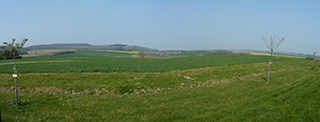Prochain point : lat="49.048227" lon="1.854266"

A panorama of the agricultural plateau of the French Vexin
Agricultural landscapes
The historic village of Jambville is clustered around the church and the château. This historic centre is connected to the hamlet of Hauts de Jambville by the alley lined with lime trees, a noteworthy feature of the landscape that dates from the nineteenth century. The commune of Jambville's territory comprises three main types of landscape which, together, are responsible for the overall image and uniqueness of the French Vexin region: the open landscape of the plateau, which affords panoramic views towards the distant horizon; the more sheltered landscape of the valleys with a more intimate ambience; and the closed-in landscape of the forests. Cereal crops are the main focus of agricultural activity in the area. Two valleys are particularly noteworthy due to their green corridors, resulting from the presence of springs: the Bernon Valley and the Valley of the Rû de l'Eau Brillante (the name of the latter means 'Bright Water Brook'). These spaces provide vital refuge for wildlife.
Hazay Farm
This is one of Jambville's six farms. It is located on the way out of the Galluis Wood, at the northernmost edge of the village and extends over 80 hectares. At the beginning of the nineteenth century, some very old buildings dating back to the feudal period still stood here. The most famous owner of the farm was Count Vitali, Prince of Sant'Eusebio, whose coat-of-arms can still be seen above the gate to this day. The counts of Vitali were benefactors in the region and were well-known for their services to society. Philippe, Count of Vitali, was responsible for restoring the church in Jambville and rebuilding the one in Frémainville.
He also facilitated access to medical care and took steps to combat illiteracy. In 1867, he was also the proprietor of the château in Vigny, the Grue Farm in Frémainville, and woods in Jambville. In Vigny, he funded fountains, roads, squares, cemeteries, barracks and a post office. His descendants continued his work and the current count still presides over numerous associations.
The Frémainville Sugar Refinery and Distillery
From 1860 to 1890, sugar beet was the primary specialised crop. After they had been harvested in the autumn, the beets were taken to be weighed. Having taken a sample, the weighman would then check its sugar content. The weighman would be the factory's best-paid worker since he was able to benefit the refinery at the farmers' expense. The beet would then be distributed to the relevant areas of the factory. A great many sugar refineries and distilleries were built during the nineteenth century as a result of this production. This was the main crop in Frémainville, where a refinery/distillery operated from 1930 to 1955. The facility manufactured beet alcohol for the chemical and pharmaceutical industries. During the Second World War, when there was a dearth of petroleum-based fuels, beet alcohol was used as alternative fuel for Parisian buses. In the course of the famous Battle of Normandy, during which the American troops arriving from Rouen were held up for several days, a German battery occupied the distillery, which suffered considerable damage. After it closed, it gradually fell into ruin, before being completely restored in 2011. This old distillery has been used as a set for various well-known films:
Diaboliquement Vôtre (Diabolically Yours) (1967), directed by Julien Duvivier and starring Alain Delon,
Les Aventures de Rabbi Jacob (The Mad Adventures of Rabbi Jacob) (1973), starring Louis de Funès, and Olivier Marchal's
36 Quai des Orfèvres (2004), starring Daniel Auteuil and Gérard Depardieu...





